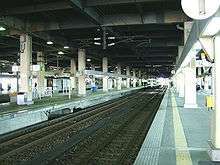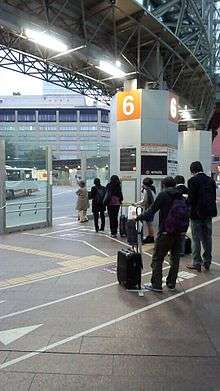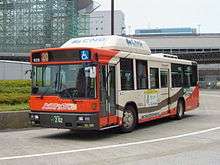Kanazawa Station
Kanazawa Station (金沢駅, Kanazawa-eki) is a major railway station in Kanazawa, Ishikawa, Japan, operated by West Japan Railway Company (JR West), the private railway operator Hokuriku Railroad, and the third-sector operator IR Ishikawa Railway.
Kanazawa Station 金沢駅 | |
|---|---|
 The Tsuzumi ("drum") Gate at JR Kanazawa Station East entrance | |
| Location | 1-1 Kinoshimbo-machi, Kanazawa-shi, Ishikawa-ken 920-0858 Japan |
| Coordinates | 36.578269°N 136.647762°E |
| Operated by |
|
| Line(s) |
|
| Distance | 450.5 km from Tokyo |
| Platforms | 5 island platforms |
| Tracks | 7 |
| Connections | Bus terminal |
| Other information | |
| Status | Staffed (Midori no Madoguchi) |
| Website | Official website |
| History | |
| Opened | April 1, 1898 |
| Traffic | |
| Passengers (FY2016) | 22,668 daily (JR West) |
| Location | |
 Kanazawa Station Location within Japan | |
Beneath a square in front of the JR station is Hokutetsu-Kanazawa Station, the terminal of the Hokuriku Railroad Asanogawa Line.
Lines
- West Japan Railway Company (JR West):
- Hokuriku Shinkansen
- Hokuriku Main Line
- Nanao Line (This line formally starts from Tsubata Station, but all the trains run straight into Kanazawa Station)
- Hokuriku Railroad (Hokutetsu):
- Asanogawa Line (Hokutetsu-Kanazawa Station)
- IR Ishikawa Railway
- IR Ishikawa Railway Line
Station layout

JR platforms
JR Kanazawa Station is elevated above street level, featuring three island platforms with one cut-out platform (for Track 4) on the Up (Toyama) side of the middle island platform, serving seven tracks in total. A large roof covers the station building, in order to prevent train stoppages due to accumulated snow within the station.
The Hokuriku Shinkansen platforms are adjacent to the east exit, between the Motenashi Dome and the conventional tracks. The shinkansen station has two island platforms serving four tracks. At the time of its opening, it will be the terminus of the line, although, long-term plans call for the route to be extended first to Tsuruga, and eventually to Osaka.
| 1 | ■ Hokuriku Main Line | (Up) | ■ Local | for Komatsu, Fukui |
|---|---|---|---|---|
| ■ Limited Express Raichō ■ Sleeper Limited Express Nihonkai |
for Fukui, Tsuruga, Kyoto, Osaka | |||
| ■ Limited Express Shirasagi | for Fukui, Tsuruga, Maibara, Nagoya | |||
| 2 | ■ Hokuriku Main Line | (Up) | ■ Local | for Komatsu, Fukui |
| ■ Limited Express Raichō, Thunderbird | for Fukui, Tsuruga, Kyoto, Osaka | |||
| ■ Limited Express Shirasagi | for Fukui, Maibara, Nagoya | |||
| 3 | ■ Hokuriku Main Line | (Up) | ■ Local | for Komatsu, Fukui |
| ■ Limited Express Raichō | for Fukui, Tsuruga, Kyoto, Osaka | |||
| ■ Limited Express Shirasagi | for Fukui, Maibara, Nagoya | |||
| ■ Nanao Line | ■ Local | for Hakui, Nanao, Wakuraonsen | ||
| 4 | ■ Nanao Line | ■ Local | for Hakui, Nanao, Wakuraonsen | |
| ■ Hokuriku Main Line | (Down) | ■Local (Ainokaze Toyama Railway Line, IR Ishikawa Railway Line) | for Takaoka, Toyama | |
| 5 | ■ Hokuriku Main Line | (Up) | ■ Local ■ Limited Express Oyasumi Express (operated by JR West) |
for Komatsu, Fukui |
| (Down) | ■ Local (Ainokaze Toyama Railway Line, IR Ishikawa Railway Line) | for Takaoka, Toyama | ||
| ■ Overnight Express Noto (operated by JR West) | for Takasaki, Ōmiya, Ueno | |||
| ■ Nanao Line | ■ Local | for Hakui, Nanao, Wakuraonsen | ||
| 6 | ■ Hokuriku Main Line | (Down) | ■ Local (Ainokaze Toyama Railway Line, IR Ishikawa Railway Line) | for Takaoka, Toyama |
| ■ Nanao Line | ■ Local | for Hakui, Nanao, Wakuraonsen | ||
| 7 | ■ Hokuriku Main Line | (Down) | ■ Local (Ainokaze Toyama Railway Line, IR Ishikawa Railway Line) ■ Limited Express Thunderbird (operated by JR West) ■ Limited Express Shirasagi (operated by JR West) ■ Limited Express Ohayō Express (operated by JR West) |
for Takaoka, Toyama |
| ■ Sleeper Limited Express Nihonkai (operated by JR West) | for Sakata, Akita, Aomori | |||
| ■ Nanao Line | ■ Local ■ Rapid Service ■ Limited Express Thunderbird ■ Limited Express Shirasagi |
for Hakui, Nanao, Wakuraonsen | ||
| 11-14 | ■ Hokuriku Shinkansen | For Toyama, Nagano, Tokyo | ||
The departure melody used on the Hokuriku Shinkansen platforms was composed by songwriter and producer Yasutaka Nakata, who was born in Kanazawa.[1]
Hokutetsu platforms
The platforms for the Hokutetsu Asanogawa Line are located underground, below the JR West platforms.
| 1-2 | ■ Hokutetsu Asanogawa Line | for Uchinada |
Adjacent stations
| « | Service | » | ||
|---|---|---|---|---|
| Hokuriku Shinkansen | ||||
| Toyama | Kagayaki | Terminus | ||
| Shin-Takaoka | Hakutaka | Terminus | ||
| Shin-Takaoka | Tsurugi | Terminus | ||
| Hokuriku Main Line | ||||
| Nishi-Kanazawa | Local | Terminus | ||
| IR Ishikawa Railway Line | ||||
| Terminus | Local | Higashi-Kanazawa | ||
| Hokutetsu Asanogawa Line | ||||
| Terminus | Local | Nanatsuya | ||
History
The station opened on 1 April 1898.[2] With the privatization of JNR on 1 April 1987, the station came under the control of JR West.[3]
From 14 March 2015, with the opening of the Hokuriku Shinkansen extension from Nagano, local passenger operations over sections of the Hokuriku Main Line running roughly parallel to the new shinkansen line were reassigned to different third-sector railway operating companies.[4] From this date, Kanazawa Station will become the western terminus of the IR Ishikawa Railway Line of Ishikawa Prefecture.[4]
Passenger statistics
In fiscal 2016, the JR West portion of the station was used by an average of 22,668 passengers daily (boarding passengers only).[5]
Surrounding area

East exit
- Kanazawa Station Bus Terminal
- Kanazawa Miyako Hotel
- Hotel Nikko Kanazawa
- Kanazawa Art Hall
- ANA Crowne Plaza Kanazawa
- Ishikawa Ongakudō
West exit
- JR Kanazawa Station West Building
- Via Inn Kanazawa
- Kanazawa Manten Hotel
- Kanazawa Water and Energy Center
Bus services
East Exit

Gate 1
- Hokutetsu bus Express bus service for Noto
Gate 2
- Hokutetsu Highway Bus (Services are operated by Hokutetsu Bus and local companies from the destination areas.)
- For Tokyo (operated by Hokutetsu Bus and Nishi Tokyo Bus)
- For Yokohama and Fujisawa (operated by Hokutetsu Bus and Enoden Bus)
- For Nagoya (operated by Hokutetsu Bus and Meitetsu Bus, JR Tokai Bus, and West JR Bus)
- For Osaka (operated by Hokutetsu Bus and Hankyu bus)
- For Sendai (operated by Hokutetsu Bus and Miyagi Kotsu)
- For Niigata (operated by Hokutetsu Bus and Niigata Kotsu)
- For Toyama (operated by Hokutetsu Bus and Toyama Chihō Railway)
- Nippon Chuo Bus[6]
- For Tokyo
Gate 3
Gate 4
- JR Bus for Fukumitsu Station and Tonami Station
Gate 5
- Machi Bus for Central Kanazawa (operated by West JR Bus)
- West JR Highway Bus (Some buses are operated by other operators)
- Dream Kanazawa for Tokyo (operated with JR Bus Kanto )
- Kanazawa Express for Tokyo (operated with JR Bus Kanto and Seibu Bus)
- For Nagoya (daytime) (operated with JR Tokai Bus)
- Hokuriku Dream Nagoya for Nagoya (night-time) (operated with JR Tokai Bus)
- For Osaka (daytime)
- For Osaka (via Fukui Station)
- For Osaka (night-time)
- For Toyama
Gate 6
- Hokutetsu Bus for Mount Utatsu and Kanazawa University
Gate 8
- Hokutetsu Bus for Kanazawa Institute of Technology
Gate 9
- Hokutetsu Bus for Kinjo University, Nonoichi City Hall, and Nonoichi Station
Gate 10
- Hokutetsu Bus for Kanazawa Gakuin University
Gate 11
- Hokutetsu Bus for Nishi-Kanazawa Station
West Exit
Gate 1
- Keifuku Bus for Awara-Yunomachi Station (Seasonal)
Gate 2
- Hokutetsu Bus Routes 52 and 57
Gate 3
- Hokutetsu Bus Komatsu Airport Bus[7]
Gate 4
- Hokutetsu Bus for Unoke Station
Gate 5
- Hokutetsu Bus for Nomachi Station, Kanazawa Gakuin University, and Kanazawa Seiryo University
Gate 6
- Hokutetsu Bus
Gate 7
- West JR Bus
Gate 8
- West JR Bus
References
- 北陸新幹線、金沢駅に中田ヤスタカ氏の発車メロディー採用 [Departure melody by Yasutaka Nakata to be used for Hokuriku Shinkansen Kanazawa Station]. Nihon Keizai Shimbun (in Japanese). Japan: Nikkei Inc. 9 December 2014. Retrieved 10 December 2014.
- 日本国有鉄道停車場一覧 [JNR Station Directory]. Japan: Japanese National Railways. 1985. p. 44. ISBN 4-533-00503-9.
- Ishino, Tetsu, ed. (1998). 停車場変遷大辞典 国鉄・JR編 [Station Transition Directory - JNR/JR]. II. Japan: JTB. p. 137. ISBN 4-533-02980-9.
- しなの鉄道(株)、えちごトキめき鉄道(株)、あいの風とやま鉄道(株)及びIRいしかわ鉄道(株)申請の第一種鉄道事業許可について [Details of railway business approval for Shinano Railway, Echigo Tokimeki Railway Company, Ainokaze Toyama Railway, and IR Ishikawa Railway]. News release (in Japanese). Japan: Ministry of Land, Infrastructure, Transport and Tourism. 26 February 2014. Retrieved 22 March 2014.
- 駅 別 運 輸 実 績 [Station passenger figures (Fiscal 2016)] (in Japanese). Japan: Ishikawa Prefectural Government. 2017. Retrieved 2 January 2018.
- Nippon Chuo Bus official website (in Japanese)
- Hokutetsu Timetable
External links
| Wikimedia Commons has media related to Kanazawa Station. |
- Kanazawa Station (JR West official page) (in Japanese)
